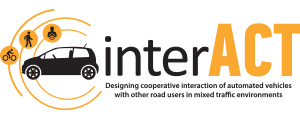As the natural traffic environment consists of a manifold variety of traffic scenes, it is essential for the technical work within the interACT project to reduce the complexity of the traffic environment to a manageable number of relevant use cases and scenarios that an AV could be confronted with. Therefore, we started the project with an agreement on and definition of relevant interACT use cases and scenarios among all industrial and academic consortium members. The interACT use cases and scenarios have been selected using a step‐wise process of intensive discussions within the consortium. Starting with some open brainstorming discussions, the use cases were aggregated and rated by the partners against several criteria (such as relevance for safety, need for interaction behaviour etc.) to agree on the most relevant ones. Among some optional use cases, the following “must‐have” use cases were defined for the project:
· React to crossing non‐motorised traffic participants at crossings without traffic light;
· React to an ambiguous situation at a non-signalised intersection involving bicyclists or motorised traffic participants;
· React to non‐motorised traffic participant at a parking space;
· React to other vehicles at a parking space.
These use cases set the common ground for the selection of the observation sites (WP2) and all further technical project work of the partners and are documented in Deliverable 1.1 . Based on the use cases the interACT partners defined several technical requirements for the development of the interACT vehicles. These requirements were assigned to the categories “General”, “Operational”, “Perception”, “Actuation” and “Human-Factors” related. In addition, the consortium documented requirements deriving from safety, security, ethical, liability and legal issues for the integration of automated vehicles in mixed environments

